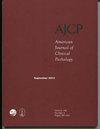通过流式细胞仪和免疫组化技术,CCR7 在区分典型霍奇金淋巴瘤和其他 B 细胞淋巴瘤方面的作用
IF 1.9
4区 医学
Q2 PATHOLOGY
引用次数: 0
摘要
目的 经典霍奇金淋巴瘤(CHL)的特征是在炎症背景下出现不常见的肿瘤性霍奇金和里德-斯登伯格(HRS)细胞。研究人员采用流式细胞术和免疫组织化学(IHC)方法探讨了CC-趋化因子受体7(CCR7)在CHL中的诊断作用。方法 对肿瘤性标本和非肿瘤性淋巴结进行免疫分型,并通过流式细胞术(克隆 3D12)和 IHC(克隆 150503)对 CCR7 的表达进行半定量测定。结果 我们的结果显示,在绝大多数 CHL 病例中,CCR7 在 HRS 细胞中表达(流式细胞术为 45/48,IHC 为 57/59),但在弥漫大 B 细胞淋巴瘤(未另作说明)和结节性淋巴细胞占优势的霍奇金淋巴瘤(流式细胞术为 0/4,IHC 为 1/13)中,CCR7 在肿瘤细胞中很少表达(流式细胞术为 1/25,IHC 为 2/40)。原发性纵隔大 B 细胞淋巴瘤(PMLBCL)的大多数病例(8/10 例)通过流式细胞术发现 CCR7 表达较弱,只有个别病例(2/12 例)通过 IHC 发现。两例(2/2)富含T细胞/组织细胞的大B细胞淋巴瘤(THRLBCL)也通过流式细胞术检测到了CCR7的表达,而通过IHC检测则为0/7。与其他 B 细胞淋巴瘤相比,HRS 细胞的 IHC 阳性比例更高,抗原强度更大。流式细胞术在 PMLBCL 和 THRLBCL 中发现了表达,而 IHC 却没有发现,这表明这两种技术或所使用的两种 CCR7 克隆的检测能力可能存在差异。结论 CCR7 在 HRS 细胞中的表达表明,它在区分 CHL 和其他 B 细胞淋巴瘤方面具有潜在的作用。将 CCR7 纳入流式细胞术和 IHC 检测板可进一步提高 CHL 的诊断灵敏度。本文章由计算机程序翻译,如有差异,请以英文原文为准。
Utility of CCR7 to differentiate classic Hodgkin lymphoma and other B-cell lymphomas by flow cytometry and immunohistochemistry
Objectives Classic Hodgkin lymphoma (CHL) is characterized by infrequent neoplastic Hodgkin and Reed-Sternberg (HRS) cells in an inflammatory background. The diagnostic utility of CC-chemokine receptor 7 (CCR7) in CHL was explored using flow cytometry and immunohistochemistry (IHC). Methods Neoplastic specimens and non-neoplastic lymph nodes were immunophenotyped and CCR7 expression was measured semiquantitatively by flow cytometry (clone 3D12) and IHC (clone 150503). Results Our results showed that CCR7 was expressed on HRS cells in the vast majority of CHL cases (45/48 by flow cytometry, 57/59 by IHC) but rarely expressed in neoplastic cells in diffuse large B-cell lymphoma, not otherwise specified (1/25 by flow cytometry, 2/40 by IHC) and nodular lymphocyte predominant Hodgkin lymphoma (0/4 by flow cytometry, 1/13 by IHC). Primary mediastinal large B-cell lymphoma (PMLBCL) revealed weak CCR7 expression by flow cytometry in most cases (8/10) but only occasionally by IHC (2/12). Both cases (2/2) of T-cell/histiocyte-rich large B-cell lymphoma (THRLBCL) also showed CCR7 expression detected by flow cytometry compared with IHC (0/7). The HRS cells demonstrated a greater percentage of positive cells and greater antigen intensity than the other B-cell lymphomas by IHC. The expression identified by flow cytometry in PMLBCL and THRLBCL but not by IHC suggests that there may be differences in the detection capabilities of the 2 techniques or the 2 CCR7 clones used. Conclusions The expression of CCR7 in HRS cells suggests its potential utility in differentiating CHL from other B-cell lymphomas. Incorporating CCR7 into flow cytometry and IHC panels may further enhance the diagnostic sensitivity of CHL.
求助全文
通过发布文献求助,成功后即可免费获取论文全文。
去求助
来源期刊
CiteScore
7.70
自引率
2.90%
发文量
367
审稿时长
3-6 weeks
期刊介绍:
The American Journal of Clinical Pathology (AJCP) is the official journal of the American Society for Clinical Pathology and the Academy of Clinical Laboratory Physicians and Scientists. It is a leading international journal for publication of articles concerning novel anatomic pathology and laboratory medicine observations on human disease. AJCP emphasizes articles that focus on the application of evolving technologies for the diagnosis and characterization of diseases and conditions, as well as those that have a direct link toward improving patient care.

 求助内容:
求助内容: 应助结果提醒方式:
应助结果提醒方式:


